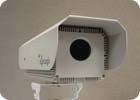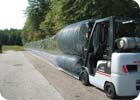Al fresco Surveillance – Know Outdoor Dangers

For perimeter monitoring, outdoor video surveillance provides information not available with other technologies.
But there is a basic challenge -- cameras that make outdoor surveillance possible are primarily designed for indoor use. The typical solution for outdoor use is to put the camera in a weatherproof enclosure; but this does not begin to solve all the problems, contends a White Paper written by Warren Simonsen of Sandra Jones and Company.
Bad illumination, shadows, rain and snow, temperature extremes, strong winds, large areas to cover, limited network connectivity and potential network vulnerability all can beat down effectiveness outside.
The White Paper lists problems and holes that need solving and filling. Understanding outdoor video challenges will make chief security officers and security directors more eager for cameras built for the great outdoors.
THE LIGHTING PROBLEM
Bright sunny days and cloudy moonless nights are extremes typical for outdoor surveillance. The sun moves from east to west all day, creating changing shadows and potential glare problems; lighting is always dynamic. Software that would attempt to detect moving objects or people needs to ignore shadows while still detecting movement in those shadows. Light reflections are common near large bodies of water or even the simple fountain or retention pond found in many industrial parks. These moving reflections often can generate false motion alarms in many systems. Simple systems attempt to eliminate this problem by masking the frame portion where this “motion” occurs. But the result is a hole in the system where motion is no longer detected at all.
THE WEATHER PROBLEM
Rain, snow and temperature extremes are hard on electronic equipment. They are the reason indoor cameras are placed in special enclosures when used outside. But even if the camera electronics are protected, temperature and precipitation can create a fog on the window the camera looks through, dramatically reducing the field of view.
THE PROBLEM WITH MOTION
Anyone who has fired a gun or looked through a telescope knows that at long distances a small change in angle at the source makes a big difference at the target. The same problem occurs with cameras mounted outdoors; the further an object is from the camera, the more a small movement of the camera appears to be large motion of the object. Wind moving a camera, even a little, can generate many false motion alarms. Video analysis software assumes that the camera is stable and not moving and wind introduces error making it difficult if not impossible to track small objects a long distance away.
THE COVERAGE PROBLEM
Longer distances and large areas are characteristics of surveillance outdoors. Usually the more area a camera can cover, the fewer cameras are needed to cover the same area. Concerning field of view, distance to the target and image resolution determine the minimum size of a detectable target, so the real key to fewer cameras is more resolution. Fortunately mega-pixel cameras are becoming commonplace today, but higher resolution is only effective if the previously described problems of lighting and stability are solved.
THE BANDWIDTH PROBLEM
High resolution video generates a lot of video data. Sending that data from a camera to a recorder or computer for analysis requires a high-speed network. However, high-speed, hardwired network connections are rare at outdoor locations. The common solution for limited network bandwidth is to limit the resolution or frame rate but that reduces the available data and, as a result, reduces the effectiveness of the coverage. Even if a high-speed network connection is available, most network administrators limit the amount of traffic dedicated to video surveillance.
THE NETWORK PERIMETER HOLE
At this time, many chief information officers have established the perimeter of their network as the first line of network defense. Firewalls and limited Internet access are used to separate the dangerous outside world from the hopefully safer internal network. Assuming a high-speed network connection is available to the camera providing outdoor surveillance, this introduces another potential problem. Any connection to the outside world must be considered a potential external network access point. Outdoor cameras connected to the network must be considered as external devices and managed accordingly.
THE INSTALLATION NIGHTMARE
As if these challenges were not enough, the solutions to these problems can be equally challenging as a CSO’s integrator attempts to manage the interactions between light levels, camera resolution and frame rate, motion sensitivity, alarm thresholds, camera calibration and bandwidth limitations. Finding the optimal settings can be frustrating and demand a knowledgeable expert.
To solve the problems and plug the holes, the White Paper urges CSOs and systems integrators to consider cameras built specifically for outside use.
About the Source
Security Magazine thanks Warren Simonsen of Sandra Jones and Company, writer of the White Paper. Simonsen’s work was under the direction of Deepam Mishra of SightLogix. For more information, e-mail Deepam at dmishra@sightlogix.com

SIDEBAR: When You’re Not Kidding Outside
Some chief security officers at sprawling campuses aren’t pussyfooting around anymore. They are using barriers, bollards and barbed tape. The challenge: such solutions take time to install and, for barriers and bollards, are mostly built into a road or entrance.
Theirs is a twist on barbed tape though – triple strand rapid deployment systems.
One source, Allied Tube & Conduit, makes such a system with a tension wire core wrapped with a stamped steel strip. Just one triple strand rapid deployment unit can deploy to cover 480 feet in less than two minutes using any vehicle with fork truck attachments. Deployment requires only two people and recovery can be accomplished with three people in less than twenty minutes, an Allied Tube & Conduit executive told Security Magazine. These solutions incorporate two 30-inch concertina coils on the ground and one 60-inch concertina coil on top to provide higher security than a single strand approach.
Looking for a reprint of this article?
From high-res PDFs to custom plaques, order your copy today!





